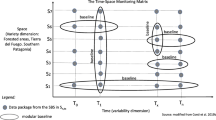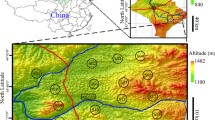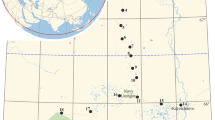Abstract
Lichen Usnea barbata transplants were tested as a biomonitor of atmospheric deposition in an apparently pristine environment that is Tierra del Fuego region (Patagonia, Argentina). The present survey is connected with the volcanic eruption that started in north Patagonia on June 4, 2011 from the Puyehue-Cordón Caulle volcano, Chile (north Patagonia, at 1700 km of distance of our sampling sites). Lichens were collected in September 2011 (one month of exposure) and September 2012 (1 year of exposure) in 27 sites covering the northern region of the province where trees are not present. The atmospheric deposition of 27 elements by using Neutron Activation Analysis (NAA) was determined in the collected samples. The first aim of the study was to evaluate the influence of the volcanic eruption on the regional atmospheric deposition comparing our results with baseline data we determined in U. barbata in 2006 in the same sites. The second aim was to test possible patterns of bioaccumulation between the two sampling campaigns after the volcanic eruption. With respect to 2006 baseline levels, we found significant higher levels for As, Ba, Co, Cr, Cs, Na, Sb and U in lichens collected after 1 month of exposure (first sampling campaign—2011). Between the two sampling campaigns (2011–2012) after the eruption, lichens reflected the natural contamination by volcanic ashes with significantly higher median levels of Br, Cr, Fe, K, Na, Sc, and Se. Results confirmed the very good aptitude of U. barbata to reflect the levels of elements in the environment at global scale and to reflect the volcanic emissions at distant places. Volcanic eruptions cause the emission in the atmosphere of elevated levels of particulate matter. In this regard, our findings demonstrate the importance to evaluate the metal composition of the particles to avoid possible health effects.



Similar content being viewed by others
References
Agnan Y, Séjalon-Delmas N, Probst A (2013) Comparing early twentieth century and present day atmospheric pollution in SW France: a story of lichens. Environ Pollut 172:139–148
Agnan Y, Séjalon-Delmas N, Probst A (2014) Origin and distribution of rare earth elements in various lichen and moss species over the last century in France. Sci Total Environ 487:1–12
Amman K, Herzig R, Liebendörfer L, Urech M (1987) Multivariate correlation of deposition data of 8 different air pollutants to lichen data in a small town in Switzerland. Ad Aerobiol 87:401–406
Armesto JJ, Rozzi R, Smith-Ramírez C, Arroyo MTK (1998) Ecology-conservation targets in South American temperate forests. Science 282:1271–1272
Arndt U, Nobel W, Schweizer B (1987) Bioindikatoren: Möglichkeiten, Grenzen und neue Erkenntnisse - Stuttgart: E. Ulmer 388
Bagnato E, Aiuppa A, Bertagnini A, Bonadonna C, Cioni R, Pistolesi M, Pedone M, Hoskuldsson A (2013) Scavenging of sulphur, halogens and trace metals by volcanic ash: the 2010 Eyjafjallajökull eruption. Geochim Cosmochim Acta 103:138–160
Bargagli R, Nimis PL (2002) Guidelines for the use of epiphytic lichens as biomonitors of atmospheric deposition of trace elements. In: Nimis PL, Scheidegger C, Wolseley PA (eds) Monitoring with lichens d monitoring lichens, NATO science series. Springer, Netherlands, pp 295–299
Bauer DF (1972) Constructing confidence sets using rank statistics. J Am Stat Assoc 67–339:687–690
Bocca B, Conti ME, Pino A, Mattei D, Forte G, Alimonti A (2007) Simple, fast, and low-contamination microwave-assisted digestion procedures for the determination of chemical elements in biological and environmental matrices by sector field ICP-MS. Int J Environ An Chem 87:1111–1123
Bode P, Van Dijk CP (1997) Operational management of results in INAA utilizing a versatile system of control charts. J Radioanal Nucl Chem 215:87–94
Brioschi L, Steinmann M, Lucot E, Pierret MC, Stille P, Prunier J, Badot PM (2013) Transfer of rare earth elements (REE) from natural soil to plant systems: implications for the environmental availability of anthropogenic REE. Plant Soil 366:143–163
Bubach D, Pérez Catán S, Arribére M, Ribeiro GS (2012) Bioindication of volatile elements emission by the Puyehue-Cordón Caulle (north Patagonia) volcanic event in 2011. Chemosphere 88:584–590
Chiarenzelli J, Aspler L, Dunn C, Cousens B, Ozarko D, Powis K (2001) Multi-element and rare earth element composition of lichens, mosses, and vascular plants from the Central Barrenlands, Nunavut, Canada. Appl Geochem 16:245–270
Conti ME (2008) Biological monitoring: theory and applications. Bioindicators and biomarkers for environmental quality and human exposure assessment. The Sustainable World, WITpress, Southampton
Conti ME, Cecchetti G (2001) Biological monitoring: lichens as bioindicators of air pollution assessment—a review. Environ Pollut 114:471–492
Conti ME, Tudino M, Stripeikis J, Cecchetti G (2004) Heavy metal accumulation in the lichen Evernia prunastri transplanted at urban, rural and industrial sites in Central Italy. J Atmos Chem 49:83–94
Conti ME, Pino A, Botrè F, Bocca B, Alimonti A (2009) Lichen Usnea barbata as biomonitor of airborne elements deposition in the Province of Tierra del Fuego (southern Patagonia, Argentina). Ecotox Environ Safe 72:1082–1089
Conti ME, Finoia MG, Bocca B, Mele G, Alimonti A, Pino A (2012) Atmospheric background trace elements deposition in Tierra del Fuego region (Patagonia, Argentina), using transplanted Usnea barbata lichens. Environ Monit Assess 184:527–538
Culicov OA, Yurukova L (2006) Comparison of element accumulation of different moss- and lichen-bags, exposed in the city of Sofia (Bulgaria). J Atmos Chem 55:1–12
Fegley B Jr, Zolotov MY (2000) Chemistry of sodium, potassium, and chlorine in volcanic gases on Io. Icarus 148:193–210
Freitas MC, Pacheco AMG (2004) Bioaccumulation of cobalt in Parmelia sulcata. Atmos Chem 49:67–82
Gaiero DM, Probst J-L, Depetris PJ, Bidart SM, Leleyter L (2003) Iron and other transition metals in Patagonian riverborne and windborne materials: geochemical control and transport to the southern South Atlantic Ocean. Geochim Cosmochim Acta 67:3603–3623
Gandois L, Agnan Y, Leblond S, Séjalon-Delmas N, Le Roux G, Probst A (2014) Use of geochemical signatures, including rare earth elements, in mosses and lichens to assess spatial integration and the influence of forest environment. Atmos Environ 95:96–104
Garty J (2001) Biomonitoring atmospheric heavy metals with lichens: theory and application. Crit Rev Plant Sci 20:309–371
Garty J, Cohen Y, Kloog N (1998a) Airborne elements, cell membranes, and chlorophyll in transplanted lichens. J Environ Qual 27:973–979
Garty J, Kloog N, Cohen Y (1998b) Integrity of lichen cell membranes in relation to concentration of airborne elements. Arch Environ Con Tox 34:136–144
Getty SR, Gutzler DS, Asmerom Y, Shearer CK, Free SJ (1999) Chemical signals of epiphytic lichens in southwestern North America; natural versus man-made sources for airborne particulates. Atmos Environ 33:5095–5104
Grasso MF, Clocchiatti R, Carrot F, Deschamps C, Vurro F (1999) Lichens as bioindicators in volcanic areas: Mt. Etna and Vulcano Island (Italy). Environ Geol 37:207–217
Hollander M, Wolfe DA (1973) Nonparametric statistical methods. New York: Wiley. 27–33 (one-sample), 68–75 (two-sample)
Hyvärinen M, Crittenden PD (1996) Cation ratios in Cladonia portentosa as indices of precipitation acidity in the British Isles. New Phytol 132:521–532
International Agency for Research on Cancer (IARC) (1990) Chromium, nickel and welding. IARC Monogr Eval Carcinog Risks Hum 49:49–256
International Agency for Research on Cancer (IARC) (2012) Arsenic, metals, fibres, and dusts. IARC Monogr Eval Carcinog Risks Hum 100c:41–94
Kularatne KIA, de Freitas CR (2013) Epiphytic lichens as biomonitors of airborne heavy metal pollution. Environ Exp Bot 88:24–32
Manta DS, Angelone M, Bellanca A, Neri R, Sprovieri M (2002) Heavy metals in urban soils: a case study from the city of Palermo (Sicily), Italy. Sci Total Environ 300:229–243
Markert BA, Breure AM, Zechmeister HG (2003) Bioindicators & biomonitors. Principles, concepts and applications. Trace metals and other contaminants in the environment, 6. Elsevier, Oxford
Mason BJ (1966) Principles of geochemistry, 3rd edn. Wiley, New York
Mather TA, Witt MLI, Pyle DM, Quayle BM, Aiuppa A, Bagnato E, Martin RS, Sims KWW, Edmonds M, Sutton AJ, Ilyinskaya E (2012) Halogens and trace metal emissions from the ongoing 2008 summit eruption of Kilauea volcano, Hawaii. Geochim Cosmochim Acta 83:292–323
Moune S, Gauthier PJ, Delmelle P (2010) Trace elements in the particulate phase of the plume of Masaya Volcano, Nicaragua. J Volcanol Geoth Res 193:232–244
Pignata ML, Plá RR, Jasan RC, Martinez MS, Rodriguez JH, Wannaz ED, Gudino L, Carreras HA, Gonzalez CM (2007) Distribution of atmospheric trace elements and assessment of air quality in Argentina employing the lichen, Ramalina celastri, as a passive biomonitor: detection of air pollution emission sources. Int J Environ Health 1:29–46
Pino A, Alimonti A, Botrè F, Minoia C, Bocca B, Conti ME (2007) Determination of twenty five elements in lichens by sector field inductively coupled plasma mass spectrometry and microwave assisted acid digestion. Rapid Commun Mass Sp 21:1900–1906
Pino A, Alimonti A, Conti ME, Bocca B (2010) Iridium, platinum and rhodium baseline concentration in lichens from Tierra del Fuego (South Patagonia, Argentina). J Environ Monit 12:1857–1863
R version 2.15.2 (2012-10-26) -- "Trick or Treat Copyright (C) 2012 The R Foundation for Statistical Computing
Richardson DHS (1995) Metal uptake in lichens. Symbiosis 18:119–127
Royston P (1982a) An extension of Shapiro and Wilk’s W test for normality to large samples. J Roy Stat Soc C-App 31:115–124
Royston P (1982b) Algorithm AS 181: the W test for normality. J Roy Stat Soc C-App 31:176–180
Royston P (1982c) Remark AS R94: a remark on algorithm AS 181: the W test for normality. J Roy Stat Soc C-App 44:547–551
Schaefer L, Fegley B Jr (2005) Alkali and halogen chemistry in volcanic gases on Io. Icarus 173:454–468
Tesche M, Glantz P, Johansson C, Norman MG, Hiebsch A, Seifert P, Ansmann A, Engelmann R, Althausen D (2012) Volcanic ash over Scandinavia originating from the Grímsvötn eruptions in May 2011. J Geophys Res 117, 9, D09201
Vieira BJ, Freitas MC, Rodrigues AF, Pacheco AMG, Soares PM, Correia N (2004) Element-enrichment factors in lichens from Terceira, Santa Maria and Madeira Islands (Azores and Madeira archipelagoes). J Atmos Chem 49:231–249
Acknowledgments
This work was in part supported by the project C26A13984B 2013, Sapienza, University of Rome, Italy.
Author information
Authors and Affiliations
Corresponding author
Additional information
Responsible editor: Céline Guéguen
Electronic supplementary material
Below is the link to the electronic supplementary material.
ESM 1
(DOCX 1107 kb)
Rights and permissions
About this article
Cite this article
Conti, M.E., Jasan, R., Finoia, M.G. et al. Trace elements deposition in the Tierra del Fuego region (south Patagonia) by using lichen transplants after the Puyehue-Cordón Caulle (north Patagonia) volcanic eruption in 2011. Environ Sci Pollut Res 23, 6574–6583 (2016). https://doi.org/10.1007/s11356-015-5858-8
Received:
Accepted:
Published:
Issue Date:
DOI: https://doi.org/10.1007/s11356-015-5858-8




